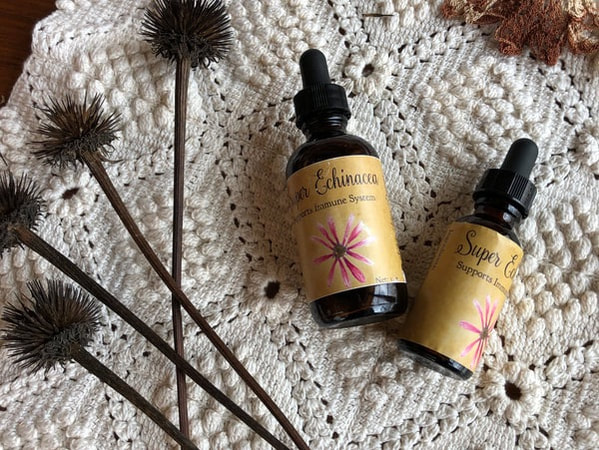|
Echinacea purpurea or Echinacea angustifolia *This blog post is featured on my Echinacea note card in a shortened form: here is a more in depth look at tincturing and making medicine with the seeds, flowers, and roots of Echinacea Echinacea is a gorgeous plant with various shades of pink radiating out from the center of its lovely flower. In the summertime, the flower and seed heads are gathered when they are in full bloom. Roots are harvested in autumn anytime before the ground freezes.
Medicinally, echinacea is most well known for its immune-boosting properties, and for good reason. Its tincture is my go-to remedy all throughout the cold and flu season. I take two or three droppers full (you can put it into warm water if you want to) at the first sign of sickness as a great way to ward off a cold before it sets in, though taken during the course of illness will also lessen its severity. Notice the tingling sensation that arises when nibbling on its root-- this is how you know it’s working! The following recipe is especially great because it’s safe for kids, nursing moms, and pregnant women. Echinacea Tincture What you’ll need: Echinacea root (fresh or dry) Menstruum (alcohol, vinegar, or vegetable glycerin) Jar & Lid Optional: Brown Dropper Bottle Notes: If fresh Echinacea root is available, it’s preferred, but dried will work just as well. Some people use the flowers and seeds in their tincture too. I tried making a tincture with all of these parts and I thought the tincture wasn't as potent as the ones I have made only utilizing the roots. I encourage you to try for yourself and find what you like! Every herbalist has their own relationship to the plants and their medicines and needs to find their own way. My experience is that alcohol makes the most potent medicine, but sometimes I prefer to use vinegar or vegetable glycerin. Some people are sensitive to alcohol. You can remove some alcohol from an alcohol tincture by placing the tincture in boiling water for 2 minutes, but this does not remove all of the alcohol, only about 50%. Vegetable glycerin tastes yummy which makes it more palatable for kiddos. It is also a great option for those in recovery. Step by Step:
2 Comments
One of the BEST cold and flu remedies is chicken soup! I think it is healing in some mysterious ways...
I once went to visit a good friend of mine and showed up with a sore throat. She had been making chicken soup, and after eating some as well as laughing with her for hours, I left feeling so much better. I don't know what in her chicken soup healed me- I’m sure the laughter helped- but I'm showcasing it as one of the best cold and flu remedies I know because that's how it has made me feel. Years ago I took a class with Betzy Bancroft (co-director of the Vermont Center of Integrative Herbalism in Montpelier) on making broth to support the immune system. She taught me about incorporating immune boosting herbs and mushrooms, like astragalus, codonopsis, shiitake, reishi, and turkey tail into my recipes. Astragalus is generally used before one gets sick to strengthen one's whole system, physically and energetically. Reishi mushrooms are another immune-boosting addition to broth, but they can add bitterness so I don’t add too much. I have made broth with and without these immune boosting additions and I find it healing either way. I also make my broth the way that nutritionist Sally Fallon recommends. She has a note in her book Nourishing Traditions “that Jewish folklore considers the addition of chicken feet the secret to successful chicken broth.” For years I made broth without chicken feet because I found them difficult to come by. This is the first winter I am actually making my broth with chicken feet! I finally found some from a local farmer who raises chickens as meat birds, who I was already purchasing meat from. I agree with this Jewish folklore because the chicken broth I’ve made without feet is nourishing and tasty but misses the gelatin quality (which makes sense because a chicken’s feet are the part of the animal that has the most ligaments and movable joints, where there is a lot of gelatin). I have noticed when I am eating chicken broth with a lot of gelatin, my digestion functions more smoothly. I’ve also noticed that my joints feel more flexible and less stiff, so I think these are just some of the healing properties of gelatin and I’m sure there’s a lot more we don’t even know about. I included a video here on how I like to process chicken feet because it's hard to describe in words. I’d like to add to this video that if you put chicken feet in boiling water for too long (in my case it was only about 20 seconds) the membrane actually cooks to the feet and makes it really, really difficult to remove. Though with practice you’ll be able to feel out the right timing by the feel of the feet. What You’ll Need: Leftover chicken bones after roasting a chicken (Backs, necks, wings, breastbones, legs) 2 to 8 chicken feet (if possible) 4 quarts water 1 large onion 2 T apple cider vinegar 2 carrots, coarsely chopped 2 to 3 stalks celery, coarsely chopped 3” to 6” piece of chopped ginger (optional) A small handful of astragalus root and/or codonopsis root (optional) Shitake, turkey tails, and/or reishi (optional) Fresh thyme (optional) Salt to taste Step by Step:
|
Sage BarberHerbalist and artist who is inspired by nature and the healing plants all around us. Archives
May 2022
|
Copyright © 2020



 RSS Feed
RSS Feed